Can You Put a Front Facing Car Seat Rear Facing
- Rear-Facing: It's Not Just for Babies Anymore
The nation's top scientists, researchers, and physicians recommend that kids sit rear-facing in the car for as long as possible, because rear-facing is safer. Here's why your 2, 3, 4 or even 5 year old should be riding rear-facing.
The American Academy of Pediatrics (AAP) has for 20+ years recommended keeping kids rear-facing until they are too big for rear-facing in their convertible seat. The AAP reiterated this in their 2018 policy statement.
The National Highway Traffic Safety Administration (NHTSA) also updated their recommendations, now specifying that children remain rear-facing until reaching "the top height or weight limit allowed by your car seat's manufacturer."
The main questions we get concerning extended rear-facing have to do with WHY it's safer, and HOW bigger kids can stay comfortable rear-facing (jump there now). It's a big topic but we've tried to address it clearly and thoroughly here. Please let us know if you have questions about this critical safety issue!
Crash Simulation: Why rear-facing is safer
At a trade show, The Car Seat Lady used a crash simulator. She wore a heavy helmet to mimic the size and weight of a child's head to really get a full body experience. Watch to see what happens and how she tolerates the different positions, and listen to her excellent description of why rear-facing is safer.
Crash Test: See how rear-facing is safer
This video shows two 12-month-old crash test dummies each secured in the same car seat. One seat is rear-facing and one is forward-facing. Watch how much the forward-facing dummy's head and neck move! Remember that this video is slowed down tremendously since crashes happen faster than the blink of an eye. For more on the physics behind why rear-facing is safer, see here.
What was going on in those crash test videos?
What is so bad about how the forward-facing dummy moved?
In a crash everyone moves towards the point of impact, so in a frontal crash everyone moves toward the front of the car. If you're forward-facing in a car-seat or a seat belt, your upper body stops quickly because the chest strap on the car seat or the seat belt holds you back. However, your head doesn't stop as quickly! Instead, it moves all the way forward until your chin touches your chest, and then goes all the way back. It whips forward and back in the blink of an eye (and is called whiplash).
Since an adult's head is just 6% of their body weight, you can withstand having your head pulled violently away from your body. You will be sore for a few days, but you hopefully won't have any lasting injury.
It's quite different for a newborn, whose head is a whopping 25% of its body. This means that if a newborn were forward-facing in a frontal crash, their head would pull forward with four times as much force as would an adult's!
Strength and rigidity of the bones in the spine also contribute to how well you can tolerate your head being pulled forward and back in a crash. The bones of an infant's spine are made up of soft, stretchy cartilage. The ligaments that connect these cartilaginous bones are also underdeveloped and stretchy. Scientists have found that a newborn's spinal column (bones + ligaments) can stretch up to 2 inches, whereas the spinal cord inside can stretch only 1/4 of an inch. If the spinal cord is forced to stretch more than it can, it breaks, leaving the baby paralyzed or worse.
Children are not just smaller adults; their bodies are differently proportioned and structured, and this difference affects their ability to tolerate the whiplash motion.
Physics: How rear-facing works to avoid injury in a crash
In a frontal crash, when everyone moves to the point of impact–the front of the car–a rear-facing baby will move in a different way. A rear-facing baby will move into the back of his car seat and will slide gently up the car seat. This allows the back of the car seat to absorb the brunt of the impact and distribute the remaining forces along the child's entire back, which is the strongest part of his body. The most important part: because he sits rear-facing, the child's head, neck, and torso all move together in a straight line. The whiplash motion is avoided totally.
What about rear-facing in a rear-end crash?
What about their legs?
Won't my child's legs be injured?
Is my child comfortable with their legs like that?
We get A LOT of questions about rear-facing kids' legs! We want to assure you that no, their legs will not be injured, and yes, they are quite comfortable with their legs like that.

Watch how legs move in a crash
The video below shows a side by side comparison of a forward-facing car seat (on the left) and a rear-facing car seat (on the right) using the same crash test dummy and the same crash speed. Watch the video and notice how the rear-facing dummy tucks into a cannonball position.No matter how scrunched the rear-facing child's legs start, they end up super scrunched during the crash. This does NOT cause injury to the legs (or other parts of the body either).
Lack of evidence of leg injury from actual crashes
There are ZERO documented cases of rear-facing children breaking their legs, hips, feet, etc., due to their feet touching the back of the vehicle seat. In fact, studies show that forward-facing kids suffer many more leg injuries than rear-facing kids. The leg injuries to forward-facing children occur when the child's legs fly up and hit the back of the front seat as the child and car seat are moving forward. This traps the child's legs, putting tremendous pressure into the leg bones. This pressure can break the legs.
Legs vs Brains
Instead of worrying about a rear-facing child's legs, we should be worrying about a forward-facing child's head and neck! Notice how the forward-facing child's head and neck are thrown forward in the video (snug straps only hold the chest back, not the head & neck), whereas the rear-facing child's head and neck are cradled within the shell of the car seat. The forward-facing child's head being thrown violently forward IS a cause for injury. This brain and spinal cord can be prevented by keeping a child rear-facing.
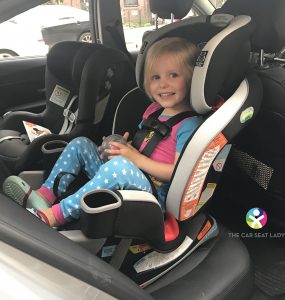
The Comfort Question
Besides worrying about leg injuries, many parents worry about leg discomfort in the rear-facing child. As kids get older, their feet will touch the back of the vehicle seat; this is both comfortable and safe.
Ever wonder why a 5-year-old can sleep comfortably with his chin on his chest and never wake up complaining of a stiff neck? It's because kids' joints aren't fully formed, which lets them sit comfortably in positions that would be painful for even a yoga master. Kids have much more flexibility and range of motion in their ankle, knee and hip joints than adults do. For this reason, a 3-year-old can sit comfortably rear-facing with their legs crossed or in the "frog leg" position.
Parents of forward-facing children will know that kids often try to put their feet up wherever they can – often the back of the front seat (which drives many adults crazy!). Forward-facing kids are doing this because they're not comfortable! Just like you aren't comfortable when you sit on a bar stool without a foot rest and your legs are left to dangle, kids don't like their legs dangling in the car seat as happens forward-facing (but doesn't happen rear-facing).
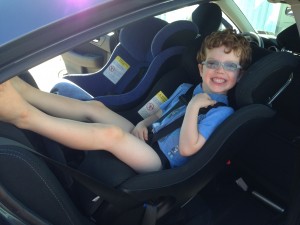
Proof kids are comfy rear-facing
I thought my child could turn forward-facing at 12 months?
This is NOT correct. Many (many) years ago, in the days before the iPhone was invented, the minimum to turn forward facing was 1 year and 20 pounds.
In 2011 both the AAP and NHTSA updated their recommendations to reflect the latest research in child passenger safety. The AAP now recommends that kids sit rear-facing until at least age 2 and for longer if possible. NHTSA now recommends: "Your child should remain in a rear-facing car seat until he or she reaches the top height or weight limit allowed by your car seat's manufacturer."
But my child's convertible car seat only goes to 20 or 22 pounds rear-facing. What do I do?
Your car seat is confusing you! Really! All convertible seats on the market in the US have for many, many years allowed rear-facing until at least 30 pounds, with most going to 40 or more pounds rear-facing. However, the labels on the car seat confuse many families, leading them to think a child must be forward-facing starting at 22 lbs.
Why? Because our government requires manufacturers to include some exceptionally confusing wording on the labels of every convertible car seat (car seats that start out rear-facing & then go forward-facing). The sentence that confuses most people is "Use only in a rear-facing position when using it with an infant weighing less than 20 lbs." What this sentence is trying to say, is that for kids who weigh less than 20 lbs. the only direction you are allowed to install this car seat is rear-facing – i.e. a child under 20 pounds may never ride forward-facing in this car seat. However, many people confuse this to mean that after 20 pounds you must turn the car seat forward-facing – which is NOT what it is trying to say.
In another sentence, likely very close to where you found the confusing one, you'll see the rear-facing maximum weight for your convertible seat, likely 40 pounds or even higher.
When is my child too big for rear-facing?
A child can be either too heavy, too tall, or both–but all of this depends on the specifications of the car seat. Each car seat has its own height and weight limits for rear-facing children. Most convertible seats allow children to sit rear-facing up to 35, 40 or 50 pounds. The height limit for most rear-facing car seats is that there must be at least 1 inch of room between the top of the child's head and the top of the car seat. This inch ensures that as the child slides up the seat in a crash, his head will stay protected.
Given the design of most car seats, the majority of children become too tall for rear-facing seats before they become too heavy. Therefore, when you purchase a convertible car seat, try to select one that is taller in seated height.
What about "off the charts" big kids?
A 95th percentile child may look stronger than his 5th percentile friend, but in a crash the bigger child is MORE at risk if he's riding forward-facing. The rigidity of bones and the strength of ligaments in the spine is likely the same in children of the same age, no matter their size. And a 95th percentile baby likely has a much larger, heavier head, which will pull forward which much more force than that of a 5th percentile child. Click here to learn about seats that can best accommodate the biggest kids rear-facing.
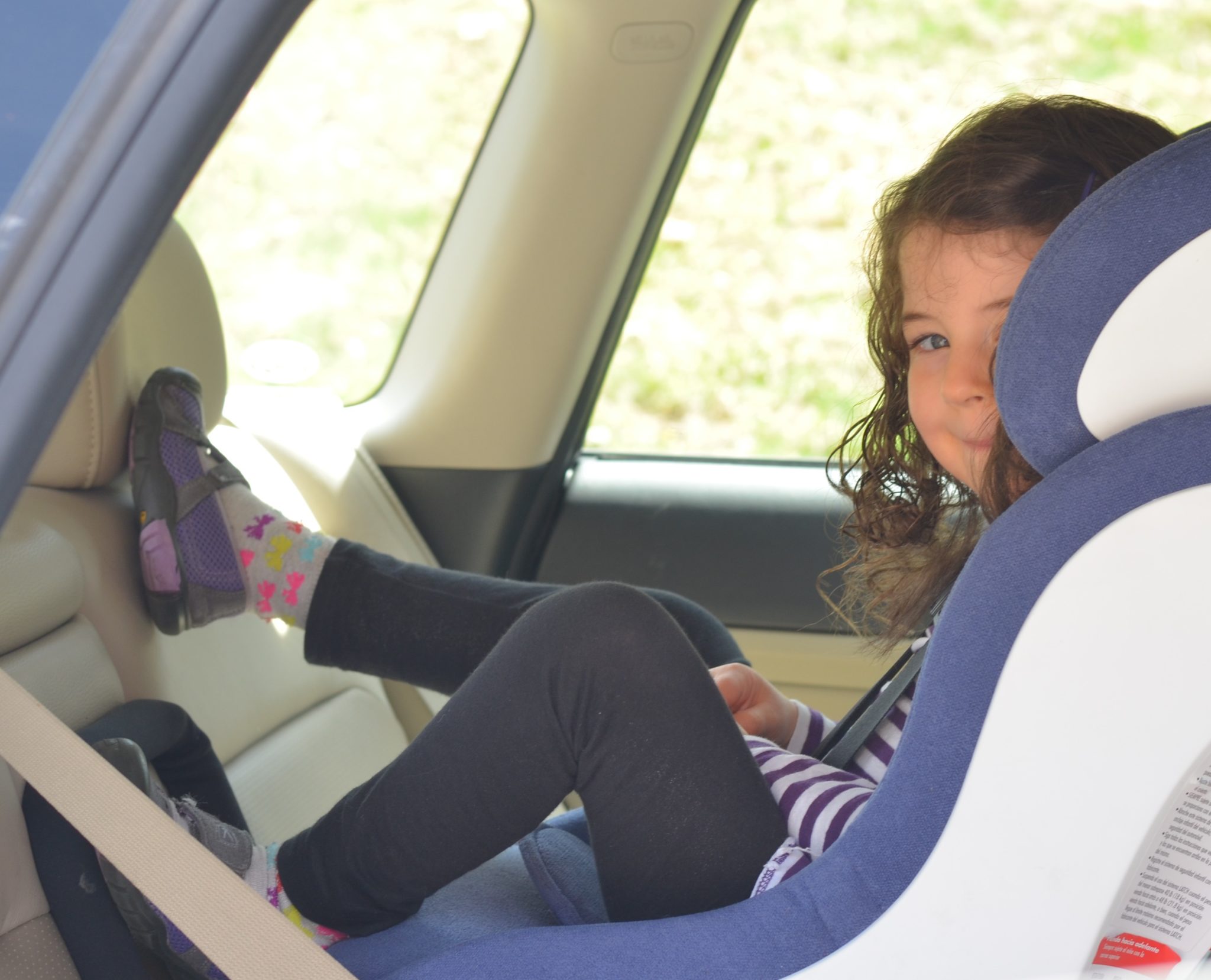
How to keep your child entertained while rear-facing
Rear-facing doesn't have to be boring! Older kids can ride quite upright so they can see out the side and rear windows. If there's a head rest blocking your child's view out the back window, you can usually remove it. By 9-12 months your baby knows you're there when you talk to them from the front – even though they can't see you. So you can calm and entertain your child with songs, stories, and for older children games of "I spy," all while they're rear-facing.
We've got lots of suggestions for great car seat & travel toys for babies & toddlers (and big kids too) because sometimes we all get a little cranky when we're bored!
The dreaded Motion Sickness! Won't it help to turn around my child?
The long and short: most kids do not puke less when forward-facing compared to rear-facing.
We've got lots of information on motion-sickness over here – including an explanation of why it is believed to occur, things you can do to decrease the chance of your kid puking, and how to minimize the mess and clean up if your kid does puke.
I already turned my kid forward-facing. Should I really turn my 2 or 3 year old back rear-facing?
Yes! When we know better, we must do better. A few months ago when you turned her forward facing you did what you thought was best, but now you know differently. Avoid regrets, and give your child the best protection.
Many parents worry that it will be a disaster turning an older child back rear-facing. Here is one mom's experience turning her almost-3-year-old son back rear-facing:
"I was initially very hesitant to move my almost three year old son to rear facing from forward facing. He has been sitting forward facing for over a year and can be strong willed when it comes to change. However, after hearing how much safer it is I was willing to try. The first three or so drives were very difficult as he asked to "look out mama and dada's window" almost the entire time. We ignored and distracted and I was about to give up when I noticed that although he still complained about sitting rear facing it happened less and less. Now (after about three weeks) he asks maybe once every other drive if he can sit forward facing and was even (mostly) fine the other day when his friend joined us and sat forward facing. It was a tough first few drives, but I am very happy we did it and I feel so much safer.
My 20 month old is too big for rear-facing in his current seat. Should I really buy another one to keep him rear-facing?
Imagine it's November and your 20-month-old has outgrown all of their winter clothes from last year. Would you not buy them new winter clothes because "it will be warmer in four months"? Of course you would buy them the clothes! The same should go for the car seat!
The car seat is one of the only products you will ever buy for your child that has the potential to save their life! Just like your child needs new clothes frequently, they may need a new car seat sooner than you thought. If you are in a crash, you will be relieved knowing that you gave them the best protection possible.
What's the law?
The laws of physics don't care about the laws of the state… but with that said, it is now law in 15 states that children ride rear-facing until at least age 2.
- California
- Connecticut
- Illinois
- Louisiana
- Maine
- Nebraska
- New Jersey
- New York
- Oklahoma
- Oregon
- Pennsylvania
- Rhode Island
- South Carolina
- Virginia
- Washington
What's the evidence?
The recommendation to keep children under age 2 rear-facing is not based on a single study, but rather on a broad body of research from the US and Sweden. These citations are included below for easy reference.
- Sherwood CP, Crandall JR. Frontal sled tests comparing rear and forward facing child restraints with 1-3 year old dummies.Annual Proceedings of the Association for the Advancement of Automotive Medicine. Association for the Advancement of Automotive Medicine, 2007,51: 169-80.
- Planath I, Rygaard C, Nilsson S. Synthesis of data towards neck protection criteria for children.Proceedings of the 1992 International IRCOBI Conference on the Biomechanics of Impacts. Verona, Italy:155-66.
- Kamren B, Koch M, Kullgren A, et al. The protective effects of rearward facing CRS: an overview of possibilities and problems associated with child restraints for children aged 0-3 years.Child Occupant Protection Symposium: SAE International, 1993.
- Klinich KD, Manary MA, Weber KB. Crash protection for child passengers: rationale for best practice.UMTRI Res Rev 2012;43:1-35.
- Isaksson-Hellman I, Jakobsson L, Gustafsson C, et al. Trends and effects of child restraint systems based on Volvo's Swedish accident database.41st Stapp Car Crash Conference: SAE International, 1997.
- Jakobsson L, Isaksson-Hellman I, Lundell B. Safety for the growing child: experiences from Swedish accident data.Proceedings of the 17th ESV Conference, 2005.
- American Academy of Pediatrics, Committee on Injury, Violence & Poison Prevention. Child Passenger Safety. Pediatrics. 2018.
- Arbogast KB, et al. Injuries to Children in Forward Facing Child Restraints. Annual Proceedings Association for the Advancement of Automotive Medicine. 2002; 46: 213-30.
Rear-facing: Not Just for Babies
Why 2, 3, 4, and even 5 year olds should be rear-facing!
The American Academy of Pediatrics (AAP) has for 20+ years recommended keeping kids rear-facing until they are too big for rear-facing in their convertible seat. This was reiterated in their 2018 policy statement.
The National Highway Traffic Safety Administration (NHTSA) also updated their recommendations, now specifying that children remain rear-facing until reaching "the top height or weight limit allowed by your car seat's manufacturer."
Our Favorite Seats for
Keeping Big Kids Rear-facing
Clek FoonfSplurge-worthy, high capacity rear-facing seat with max safety features: anti-rebound bar and rear-facing tether. Optimized for installation on side seats. Narrow exterior and wide interior gives child max room while taking up less room in car than many infant seats. Also has max safety features for forward-facing: rigid LATCH + crumple zone.Buy HereClek FlloHigh capacity rear-facing seat with max safety features: anti-rebound bar and rear-facing tether. Optimized for installation in center seat. Narrow exterior and wide interior gives child max room. Great in 3-across when RF in center seat.Buy HereGraco Extend2FitHighest rear-facing capacity of any seat in US for both tallest and heaviest kids. Fits well in small cars behind tall drivers while giving child lots of leg room. Budget friendly! Note: we do not recommend the Platinum or 4Ever models – we like the basic 2-in-1 model best!Buy Here
Previous
Next
15 states now require kids to remain rear-facing until at least their 2nd birthday.
Whoa… you might be thinking "how does a 2-year-old fit rear-facing"… take 90 seconds and watch the following video – and you'll see how these 90 different 2 year olds all ride safely and comfortably rear-facing.
Common Questions about Rear-facing
Why is rear-facing safer than forward-facing?
Instead of having your head pull violently away from your chest, as happens when you are forward-facing in a frontal crash, the rear-facing child is cradled in their seat in much the same way as you catch a fastball in a mitt.
This video shows two 12-month-old crash test dummies each secured in the same car seat but one is rear-facing and one is forward-facing – watch how much the forward-facing dummy's head and neck move – and remember that this video is slowed down tremendously as crashes happen quicker than the blink of an eye. For more on the physics behind why rear-facing is safer, see here.
What about their legs? Isn't it unsafe and/or uncomfortable?
The video above shows a side by side comparison of a forward-facing car seat (on the left) and a rear-facing car seat (on the right) using the same crash test dummy and the same crash speed.
Notice how the rear-facing dummy tucks into a cannonball position? No matter how scrunched the rear-facing child's legs start, they end up super scrunched during the crash and it does NOT cause injury to the legs (or other parts of the body either).There are ZERO documented cases of rear-facing children breaking their legs, hips, feet, etc., due to their feet touching the back of the vehicle seat. In fact, studies show that forward-facing kids suffer many more leg injuries than rear-facing kids. The leg injuries to forward-facing children occur when the child's legs fly up and hit the back of the front seat all the while the child & car seat are moving forward which traps the child's legs and puts tremendous pressure into the leg bones which can break them.
What you should be asking is "What about the HEAD & NECK?" – notice how the forward-facing child's head and neck are thrown forward (snug straps only hold the chest back, not the head & neck) – whereas the rear-facing child's head and neck are cradled within the shell of the car seat. The forward-facing child's head being thrown violently forward IS a cause for brain and spinal cord injury… injury we can prevent by keeping a child rear-facing.
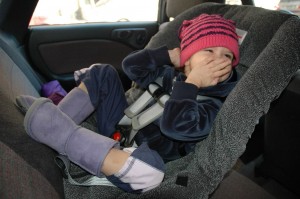
3-year-old happily rear-facing
Besides worrying about leg injuries, many parents worry about leg discomfort in the rear-facing child. As kids get older, their feet will touch the back of the vehicle seat; this is both comfortable and safe. Ever wonder why a 5-year-old can sleep comfortably with his chin on his chest and never wake up complaining of a stiff neck? It's because kids' joints aren't fully formed, which lets them sit comfortably in positions that would be painful for even a yoga master. Kids have much more flexibility and range of motion in their ankle, knee and hip joints than we do. For this reason, a 3-year-old can sit comfortably rear-facing with her legs crossed or in the "frog leg" position.
Parents of forward-facing children will know that the kids often try and put their feet up wherever they can – often the back of the front seat (which drives many adults crazy!). Forward-facing kids are doing this as just like you aren't comfortable when you sit on a bar stool without a foot rest and your legs are left to dangle, they don't like their legs dangling in the car seat as happens forward-facing (but doesn't happen rear-facing).
What about rear-facing in a rear-end crash?
A recent study looked at rear-facing car seats in rear impacts. They study found that rear-facing car seats mitigate and manage crash forces in a variety of ways that allow them to provide good protection for rear-facing kids. This finding is backed up by epidemiological and field data which also show that real kids riding rear-facing in real rear-end crashes typically do very well.
Someone told me I can turn my child forward-facing at 1 year and 20 pounds. Is this correct?
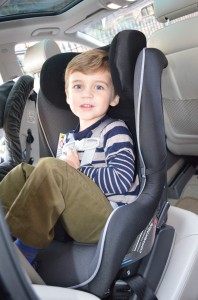
This is NOT correct. Many years ago, in the days before the iPhone was invented, the minimum to turn forward facing was 1 year and 20 pounds.
In 2011 both the AAP and NHTSA updated their recommendations to reflect the latest research in child passenger safety. The AAP now recommends that kids sit rear-facing until at least age 2. NHTSA now recommends: "Your child should remain in a rear-facing car seat until he or she reaches the top height or weight limit allowed by your car seat's manufacturer."
But my child's convertible car seat only goes to 20 or 22 pounds rear-facing. What do I do?
Our government requires manufacturers to include some exceptionally confusing wording on the labels of every convertible car seat (car seats that start out rear-facing & then go forward-facing). The sentence that confuses most is "Use only in a rear-facing position when using it with an infant weighing less than 20 lbs." What this sentence is trying to say, is that for kids who weigh less than 20 lbs. the only direction you are allowed to install this car seat is rear-facing – i.e. a child under 20 pounds may never ride forward-facing in this car seat. However, many people confuse this to mean that after 20 pounds you must turn the car seat forward-facing – which is NOT what it is trying to say. In another sentence, likely very close to where you found the confusing one, it will give the rear-facing minimum and maximum weights for your convertible seat. All convertible seats on the market in the US for many years now go rear-facing until at least 30 pounds, with most going to 40 or more pounds rear-facing.
When is a child TOO BIG for rear-facing?
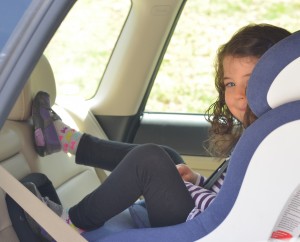 A child can be either too heavy, too tall, or both–but all of this depends on the specifcations of the car seat. Each car seat has its own height and weight limits for rear-facing children. Most convertible seats allow children to sit rear-facing up to 35, 40 or 50 pounds. The height limit for most rear-facing car seats is that there must be at least 1 inch of room between the top of the child's head and the top of the car seat. This inch ensures that as the child slides up the seat in a crash, his head will stay protected. Given the design of most car seats, the majority of children become too tall for rear-facing seats before they become too heavy. Therefore, when you purchase a convertible car seat, try to select one that is taller in seated height.
A child can be either too heavy, too tall, or both–but all of this depends on the specifcations of the car seat. Each car seat has its own height and weight limits for rear-facing children. Most convertible seats allow children to sit rear-facing up to 35, 40 or 50 pounds. The height limit for most rear-facing car seats is that there must be at least 1 inch of room between the top of the child's head and the top of the car seat. This inch ensures that as the child slides up the seat in a crash, his head will stay protected. Given the design of most car seats, the majority of children become too tall for rear-facing seats before they become too heavy. Therefore, when you purchase a convertible car seat, try to select one that is taller in seated height.
What about big kids – those who are "off the charts"?
A 95th percentile child may look stronger than his 5th percentile friend, but in a crash the bigger child is MORE at risk if he's riding forward-facing. The rigidity of bones and the strength of ligaments in the spine is likely the same in children of the same age, no matter their size. And a 95th percentile baby likely has a much larger, heavier head, which will pull forward which much more force than that of a 5th percentile child. Click here to learn about seats that can best accommodate the biggest kids rear-facing.
What if my child is unhappy riding rear-facing?

Rear-facing does not have to be boring! Older kids can ride quite upright so they can see out the side and rear windows. If there is a head rest blocking your child's view out the back window, you can usually remove it. By 9-12 months your baby knows you're there when you talk to them from the front – even though they can't see you. So you can calm and entertain your child with songs, stories – and for older children games of "I spy" – all while they are rear-facing.
We've got lots of suggestions for great car seat & travel toys for babies & toddlers (and big kids too) – check them out here – because sometimes we all get a little cranky when we're bored!
What are some good toys for rear-facing kiddos?
We've got a pediatrician-curated selection of toys, teethers, and games that are car seat & travel friendly for babies, toddlers & big kids. We all get a little cranky when we're bored – and these are sure to keep boredom at bay!
What about kids who get motion sick?
The long and short: most kids do not puke less when forward-facing compared to rear-facing.
We've got lots of information on motion-sickness over here – including an explanation of why it is believed to occur, things you can do to decrease the chance of your kid puking, and how to minimize the mess and clean up if your kid does puke.
I already turned my 1 year old forward-facing – should I really turn her back rear-facing?

Yes! When we know better, we must do better. Three months ago when you turned her forward facing you did what you thought was best, but now you know differently. Avoid regrets, and give her the best protection.
Many parents worry that it will be a disaster turning an older child back rear-facing. Here is one mom's experience turning her almost-3-year-old son back rear-facing:
"I was initially very hesitant to move my almost three year old son to rear facing from forward facing. He has been sitting forward facing for over a year and can be strong willed when it comes to change. However, after hearing how much safer it is I was willing to try. The first three or so drives were very difficult as he asked to "look out mama and dada's window" almost the entire time. We ignored and distracted and I was about to give up when I noticed that although he still complained about sitting rear facing it happened less and less. Now (after about three weeks) he asks maybe once every other drive if he can sit forward facing and was even (mostly) fine the other day when his friend joined us and sat forward facing. It was a tough first few drives, but I am very happy we did it and I feel so much safer.
I already turned my 1 year old forward-facing – should I really turn her back rear-facing?

Yes! When we know better, we must do better. Three months ago when you turned her forward facing you did what you thought was best, but now you know differently. Avoid regrets, and give her the best protection.
Many parents worry that it will be a disaster turning an older child back rear-facing. Here is one mom's experience turning her almost-3-year-old son back rear-facing:
"I was initially very hesitant to move my almost three year old son to rear facing from forward facing. He has been sitting forward facing for over a year and can be strong willed when it comes to change. However, after hearing how much safer it is I was willing to try. The first three or so drives were very difficult as he asked to "look out mama and dada's window" almost the entire time. We ignored and distracted and I was about to give up when I noticed that although he still complained about sitting rear facing it happened less and less. Now (after about three weeks) he asks maybe once every other drive if he can sit forward facing and was even (mostly) fine the other day when his friend joined us and sat forward facing. It was a tough first few drives, but I am very happy we did it and I feel so much safer.
My 20-month-old is too heavy for rear-facing in his current seat – should I really buy a different seat so he can ride rear-facing longer?
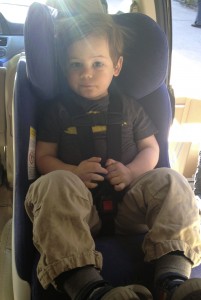
Imagine it's November and your 20-month-old has outgrown all of her winter clothes from last year. Would you not buy her new winter clothes because "it will be warmer in four months"? The car seat is one of the only products you will ever buy for your child that has the potential to save her life! Just like your child needs new clothes frequently, they may need a new car seat sooner than you thought. If you are in a crash, you will be relieved knowing that you gave her the best protection possible.
What is the law?
The laws of physics don't care about the laws of the state… but with that said, it is now law in 15 states that children ride rear-facing until at least age 2.
- California
- Connecticut
- Illinois
- Louisiana
- Maine
- Nebraska
- New Jersey
- New York
- Oklahoma
- Oregon
- Pennsylvania
- Rhode Island
- South Carolina
- Virginia
- Washington
What is the evidence?
It is critically important to understand that the recommendation to keep children under age 2 rear-facing is not based on a single study, but rather on a broad body of research from the US and Sweden. These citations are included below for easy reference.
- Sherwood CP, Crandall JR. Frontal sled tests comparing rear and forward facing child restraints with 1-3 year old dummies.Annual Proceedings of the Association for the Advancement of Automotive Medicine. Association for the Advancement of Automotive Medicine, 2007,51: 169-80.
- Planath I, Rygaard C, Nilsson S. Synthesis of data towards neck protection criteria for children.Proceedings of the 1992 International IRCOBI Conference on the Biomechanics of Impacts. Verona, Italy:155-66.
- Kamren B, Koch M, Kullgren A, et al. The protective effects of rearward facing CRS: an overview of possibilities and problems associated with child restraints for children aged 0-3 years.Child Occupant Protection Symposium: SAE International, 1993.
- Klinich KD, Manary MA, Weber KB. Crash protection for child passengers: rationale for best practice.UMTRI Res Rev 2012;43:1-35.
- Isaksson-Hellman I, Jakobsson L, Gustafsson C, et al. Trends and effects of child restraint systems based on Volvo's Swedish accident database.41st Stapp Car Crash Conference: SAE International, 1997.
- Jakobsson L, Isaksson-Hellman I, Lundell B. Safety for the growing child: experiences from Swedish accident data.Proceedings of the 17th ESV Conference, 2005.
- American Academy of Pediatrics, Committee on Injury, Violence & Poison Prevention. Child Passenger Safety. Pediatrics. 2018.
- Arbogast KB, et al. Injuries to Children in Forward Facing Child Restraints. Annual Proceedings Association for the Advancement of Automotive Medicine. 2002; 46: 213-30.
We are a reader supported site. We earn an affiliate commission when you buy through our links.
FTC Disclosure: Affiliate links are included in this page. No monetary compensation was provided, however, some of the reviewed products were supplied by the manufacturer or distributor to help facilitate the review. All opinions are those of The Car Seat Lady LLC.
Can You Put a Front Facing Car Seat Rear Facing
Source: https://thecarseatlady.com/when-should-your-child-turn-forward-facing/